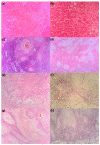Assessment of Histological Features in Squamous Cell Carcinoma Involving Head and Neck Skin and Mucosa
- PMID: 34071843
- PMCID: PMC8199467
- DOI: 10.3390/jcm10112343
Assessment of Histological Features in Squamous Cell Carcinoma Involving Head and Neck Skin and Mucosa
Abstract
Background: squamous cell carcinoma (SCC) is the second most common type of malignancy worldwide. Skin and mucosa of the head and neck areas are the most frequently affected. An aggressive behavior in SCC is not easily detected, and despite all efforts, mortality in these types of cancer did not show major improvements during recent decades. In this study, we aim to determine the role of histological features available through standard pathology assessment in SCC and their relation with tumor behavior and patients' survival.
Method: in a group of one hundred patients diagnosed with SCC involving the head and neck areas, we assessed the presence of four histological features (tumor/stroma ratio, immune infiltration at the front of invasion, tumor-budding activity, and tumor necrosis), their correlations with tumor type (mucosal or cutaneous), tumor clinicopathological characteristics, and their prognostic potential.
Results: the comparison between histological features in cutaneous versus mucosal SCC reveals no significant differences for any of the four parameters assessed. We found significant correlations between tumor/stroma ratio and lymphatic metastasis (p = 0.0275), perineural invasion (p = 0.0006), and clinical staging (p = 0.0116). Immune infiltration at the front of invasion revealed similar correlations with lymph node involvement (p = 0.002), perineural invasion (p = 0.0138), and clinical staging (p = 0.0043). Tumor budding and tumor necrosis correlated with the size of the tumor (p = 0.0077 and p = 0.0004) and the clinical staging (p = 0.0039 and p = 0.0143). In addition, tumor budding was significantly correlated with perineural invasion (p = 0.0454). In mucosal SCC, patients with improved outcome revealed high values for the tumor/stroma ratio (p = 0.0159) and immune infiltration at the front of invasion (p = 0.0274). However, the multivariate analysis did not confirm their independent prognostic roles.
Conclusions: extended histological assessments that include features such as tumor/stroma ratio, immune infiltration at the front of invasion, tumor budding, and tumor necrosis can be an easy, accessible method to collect additional information on tumor aggressiveness in skin and mucosa SCC affecting the head and neck areas.
Keywords: head and neck; histopathology; immune infiltration; necrosis; prognostic; squamous cell carcinoma; tumor budding; tumor/stroma ratio.
Conflict of interest statement
The authors declare no conflict of interest. The funders had no role in the design of the study; in the collection, analyses, or interpretation of data; in the writing of the manuscript; or in the decision to publish the results.
Figures



Similar articles
-
Parotid metastasis--an independent prognostic factor for head and neck cutaneous squamous cell carcinoma.J Plast Reconstr Aesthet Surg. 2006;59(12):1288-93. doi: 10.1016/j.bjps.2006.03.043. Epub 2006 Jun 5. J Plast Reconstr Aesthet Surg. 2006. PMID: 17113505
-
Clinicopathological correlation of tumor-stroma ratio and inflammatory cell infiltrate with tumor grade and lymph node metastasis in squamous cell carcinoma of buccal mucosa and tongue in 41 cases with review of literature.J Cancer Res Ther. 2020 Apr-Jun;16(3):445-451. doi: 10.4103/0973-1482.193113. J Cancer Res Ther. 2020. PMID: 32719249 Review.
-
The prognostic value of morphologic findings for lung squamous cell carcinoma patients.Pathol Res Pract. 2016 Jan;212(1):1-9. doi: 10.1016/j.prp.2015.10.006. Epub 2015 Oct 31. Pathol Res Pract. 2016. PMID: 26608418
-
Tumour Budding Correlates with Aggressiveness of Cutaneous Squamous-cell Carcinoma.Anticancer Res. 2016 Sep;36(9):4781-5. doi: 10.21873/anticanres.11036. Anticancer Res. 2016. PMID: 27630328
-
Diagnosis and treatment of invasive squamous cell carcinoma of the skin: European consensus-based interdisciplinary guideline.Eur J Cancer. 2015 Sep;51(14):1989-2007. doi: 10.1016/j.ejca.2015.06.110. Epub 2015 Jul 25. Eur J Cancer. 2015. PMID: 26219687 Review.
Cited by
-
Combined Model of Tumor-Stroma Ratio and Tumor Budding Are Not Associated with Tumor Recurrence or Metastasis in Oral Squamous Cell Carcinoma Patients.Diagnostics (Basel). 2025 Jul 22;15(15):1844. doi: 10.3390/diagnostics15151844. Diagnostics (Basel). 2025. PMID: 40804808 Free PMC article.
-
The Hidden Treasures of Preoperative Blood Assessment in Oral Cancer: A Potential Source of Biomarkers.Cancers (Basel). 2021 Sep 5;13(17):4475. doi: 10.3390/cancers13174475. Cancers (Basel). 2021. PMID: 34503285 Free PMC article.
-
PTCH1 Gene Variants, mRNA Expression, and Bioinformatics Insights in Mexican Cutaneous Squamous Cell Carcinoma Patients.Biology (Basel). 2024 Mar 16;13(3):191. doi: 10.3390/biology13030191. Biology (Basel). 2024. PMID: 38534460 Free PMC article.
-
Assessment of Serum Urea, Creatinine and Uric Acid in Oral Cancer.J Clin Med. 2022 Jun 16;11(12):3459. doi: 10.3390/jcm11123459. J Clin Med. 2022. PMID: 35743528 Free PMC article.
-
Prognostic Significance of Tumor-Stroma Ratio (TSR) in Head and Neck Squamous Cell Carcinoma: Systematic Review and Meta-Analysis.Cells. 2024 Oct 26;13(21):1772. doi: 10.3390/cells13211772. Cells. 2024. PMID: 39513879 Free PMC article.
References
-
- Boscolo-Rizzo P., Zorzi M., Mistro A.D., Da Mosto M.C., Tirelli G., Buzzoni C., Rugge M., Polesel J., Guzzinati S. The Evolution of the Epidemiological Landscape of Head and Neck Cancer in Italy: Is There Evidence for an Increase in the Incidence of Potentially HPV-Related Carcinomas? PLoS ONE. 2018;13:e0192621. doi: 10.1371/journal.pone.0192621. - DOI - PMC - PubMed
Grants and funding
LinkOut - more resources
Full Text Sources
Research Materials

